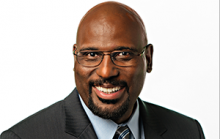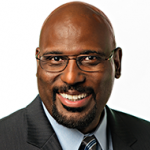Innovation is becoming synonymous with digital technology, as businesses across all categories and industries come to the conclusion that you can't have one without the other.
Faced with these external pressures while also focusing on the future, Terry Bradwell, chief enterprise strategy and innovation officer for AARP, decided that if he was going to move the business of AARP forward, he was going to need to transform his IT organization from a supporting role to one that was much more entrepreneurial. The Enterprisers Project caught up with Bradwell to learn how he accomplished this goal and his advice for other CIOs.
The Enterprisers Project (TEP): Can you tell us about an IT-led initiative that you are particularly proud of?

Bradwell: Yes. Let me set the scene. Our annual member event – Life @50+ - is one of the biggest conferences that we have all year. Thousands of our 38 million members attend to experience days of engagement, including speaker series, political candidate appearances, entertainers, trade show, and a host of activities for our members to experience. We noticed that one of the biggest draws on our trade show floor wasn’t celebrity appearances or exhibitors that had cool giveaways. It was the basic training on how to use mobile technology. That exhibit was so crowded that the fire marshal intervened for crowd control. It was quite obvious to us that our members not only needed help in this area, they were quite hungry for it.
Based on this observation, I assembled a small team from my IT staff to conduct some field research as well as leverage existing internal and external research. We quickly realized that there wasn't just a gap in technology education and training for older Americans – there was a huge divide. This audience was missing out on valuable products, services, and more importantly, engagement with their family and community.
Now inherently we knew this, but sometimes the things that you know inherently are not easily shaped into opportunities that are actionable. So we looked within our organization to see if anyone was doing or planning anything holistically in regards to technology education for older adults, and there were a few small initiatives that had been done, but they were primarily one-offs.
In line with our mission of empowering people to live their best lives, and understanding that personal technology is an imperative in our lives now, we felt that it was AARP’s duty to create a unique experience that provides a warm and welcoming environment to learn. This was an opportunity for our IT organization to have a direct impact to AARP’s bottom line to engage and service our members in the most relevant way. So we got to work launching a comprehensive national hands-on technology education program called AARP TEK that is tailored to older adults.
TEP: How did you get the rest of the organization on board?
Bradwell: I assembled a small group of the most entrepreneurial and innovative resources from my team and developed a proof of concept so that we could experiment in a small but powerful and impactful way. We found many creative ways to self-fund AARP TEK by leveraging savings from efficiency and rationalization initiatives as well as getting pro-bono help from several of our long term strategic IT partners like IBM, HCL and Ciber that believe in our core mission. To me this is what I mean by truly running IT like a business. Historically, our IT organization did not have a reputation for bringing to life new concepts or ideas that yielded a product or a service, so I didn't want to request incremental funds for a speculative venture without any credibility. My plan was to rapidly test, learn, prove there’s value to our members, and then integrate the concept into the appropriate part of AARP to bring it to scale.
After developing a proof of concept, we were able to showcase it at our Member Event in Atlanta where approximately 15,000 people attended. You would have thought we were opening up an Apple store. There were lines around the convention center and when each class was over, no one got up. They wanted more. The capabilities that most people take for granted – things like video chatting, or sending a picture to a relative, or accessing a location on a map - are concepts that were very new to many of the participants. And note, these are very smart people who had a lifetime of learning, but they simply never had the opportunity to learn and embrace the technology that is relevant today. It was amazing to see what 45 minutes of technology training did to transform their lives. Fear transformed to genuine curiosity, and anxiety transformed to smiles and laughter for all we engaged. Of the thousands that attended over 98 percent said they would recommend to a friend or take additional classes if offered. We absolutely had a winning concept on our hands.
Like with real estate, location and proximity is important. It was risky, but we deliberately choose to conduct the pilot at our largest event because it guaranteed that we received attention from internal stakeholders such as the CEO, my executive colleagues, as well as our board of directors. After that, it was like wildfire. In 2014, we expanded the pilot to five states and ensured we had a lens on our multi-cultural/language audience, and by the end of 2015 this offering will be available in 15 more states with growth to 25 states in 2016. Today AARP TEK has become one of AARP’s signature national programs with major sponsorships by companies such as AT&T and Consumer Cellular and a dedicated business unit to drive and grow it to even larger heights. But for me, the cool factor is that AARP TEK was something that was born within IT, incubated within IT, proved within IT, and ultimately provides tremendous value for the audience we serve, so we're very proud.
TEP: What are some of the benefits you are seeing both within IT and for AARP as a whole?
Bradwell: AARP TEK not only gave us new ways to engage our members, but our traditional IT business partners as well. It's mutually beneficial because they’re finding a new audience that they found hard to connect to, and the program is opening up a new revenue stream for the AARP to fund our social mission. By taking a leadership position on this huge, previously untapped need, we enabled AARP to stimulate the technology market to do more for our older population as well.
Another benefit is that IT's credibility has risen within the organization tremendously, and rather than turning to us solely for tech support and system implementations, they are looking to IT for more innovative ideas that will continue to move the business of AARP forward.
Another exciting IT driven initiative is the launch of our first retail product ever at AARP, which was a tablet device geared toward older Americans, called the RealPad. This was co-developed from the ground up with Intel and launched in the fall of 2014. The product has had a wonderful reception in the marketplace and overall we’ve received very favorable reviews from technology critics. We introduced this device not to make money on it, but to stimulate the market and get the industry to pay more attention to the 60-and-above audience when it comes to technology design and support. Both RealPad and AARP TEK are two bold initiatives that may not traditionally have come from IT; however, they have contributed to the innovation that the organization needed to integrate our tangible offerings more into the digital realm.
ALSO READ
- Practical ways to approach digital transformation in your enterprise
- CIOs: Make customer experience a priority
Terry Bradwell, AARP’s chief enterprise strategy & innovation officer, helps shape AARP’s future through the development of a clear enterprise strategy and a strong innovation pipeline. He is responsible for strategic planning, corporate relations and an innovation lab that continually looks at how we can do our work better and discover new solutions that help our members and people 50+ live their best lives. With over 25 years of domestic and international experience in information technology development, delivery and management, he has held a number of senior leadership positions. As AARP’s Chief Information Officer, he transformed the IT organization from a “cost center” to a “value center,” running IT like a business and stimulating innovation across the enterprise and closing the gap in digital literacy for the 50+.




